Travis Audubon: April bird forecast

What to watch for in April: Charismatic Flycatchers
AUSTIN (KXAN) — April is an especially exciting time to watch birds. Late March saw early migrating songbirds and shorebirds, and that trickle will turn to a stream of warblers, vireos, buntings, hawks, gulls, shorebirds, and others as the month progresses.
Some newly arriving flycatchers are often heard before they are seen, from the 6 inch uncommon twittering Vermilion Flycatchers to larger noisy flycatchers like the 10 inch Scissor-tailed Flycatcher and 9 inch Western Kingbird. Follow their calls to track them down, often with just a little effort. You may not even need to binoculars to enjoy them.
Here’s the Central Texas bird forecast for the month, courtesy of Travis Audubon. Learn more about Central Texas birds and bird-related events for all ages at travisaudubon.org or by calling 512-300-BIRD. Follow us at www.facebook.com/travisaudubon.
Spectacular Scissor-tails Scissor-tailed Flycatchers started popping up in late March and more will come through in April. Some will nest here, and others will hopscotch over local breeders heading to their breeding grounds in Oklahoma, Kansas and a small bit of southeastern New Mexico. A few summer in northeastern Mexico. The U.S. population winters in Mexico and Central America. One study of Scissor-tail breeding biology found that the males arrived on territory in Fort Sill, Oklahoma 11-17 days before the earliest arriving females. That may explain why you see solo birds in early migration.
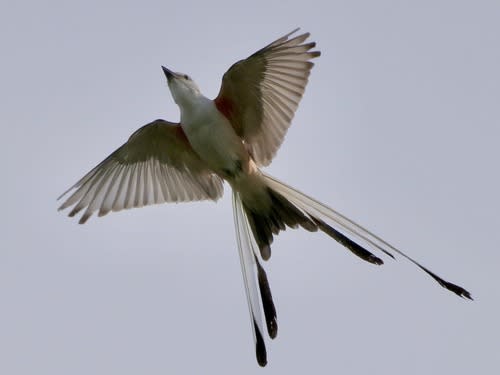
COURTESY: Jeff Osborne
Scissor-tails have very long tails, with males’ tails on average being much longer than females. The long tails are an adaptation that gives them maneuverability as they chase their insect prey, primarily grasshoppers and beetles. They often perch out in the open, especially on fence lines and wires. They fly out from their perches to catch prey in flight, and often return to perches to subdue and consume bigger items by whacking them repeatedly. Scissor-tails also catch and eat insects on the ground.
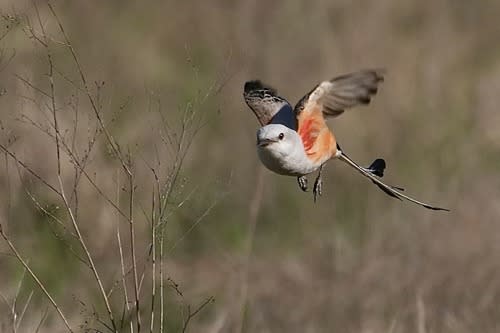
COURTESY: Jeff Osborne
Look for Scissor-tails in open country grassy habitat with scattered shrubs and trees for nesting. They will use farm fields and pastures along with golf courses and parks too.
Pairs are monogamous for the season, and both actively defend their breeding territory. The females build the cup-shaped nests and incubate the eggs, but the males help feed the young. If you see a nest don’t disturb the birds, but look to see how the female handles that long tail while incubating.
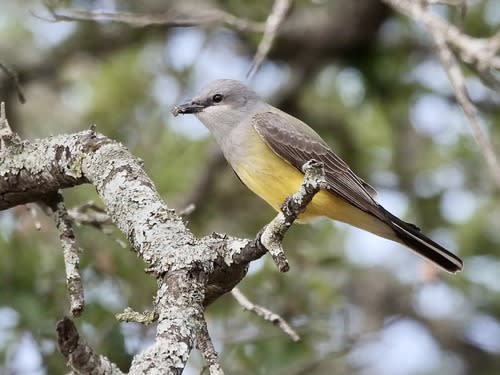
COURTESY: Jeff Osborne
Good places around town to see Scissor-tails are Bob Wentz Windy Point Park, Commons Ford Park, Roy Guerrero Park and Hornsby Bend. Listen for a loud repeated “pip” or a more prolonged loud “pidik pek pik pik pidEEK” that goes up at the end.
Kingbirds Rule The Western Kingbird is another very visible flycatcher that arrives in April from its wintering grounds in southern Mexico and Central America. It has a much larger breeding range than the Scissor-tails. It’s well-named as it can be found in the western U.S. from Texas up to the Dakotas and southern Canada, over to Washington and down through California and the states in between, with some breeding in Mexico.
The Western Kingbird appears to be expanding its range and numbers may be increasing slightly. It prefers open areas for foraging, where it likes to fly out from a perch, or from the perch to the ground, to catch insects. Trees and shrubs are preferred nest and perch sites. It is adaptable to many man-made alterations to its habitat such as forest clearing. The increasing number of utility poles and wires are used for perching, and the braces connecting transformers to utility poles are extremely popular nest sites. Various species of trees are also used, and study data indicates that birds prefer to build the cup-shaped nests in the upper third of a tree, regardless of the tree height. The female builds the nest, and does the incubating. Both sexes feed the nestlings.
Western Kingbirds are similar in appearance to the Couch’s Kingbird, another yellow-bellied kingbird that occurs in Austin in small numbers. The yellow on the Couch’s goes higher up on the breast than in the Western. It has a greenish-yellow back compared to the gray-green back on the Western. The Couch’s lacks the Western’s white outer tail feathers. If all this makes your head spin listen for the “breer” call of the Couch’s and the “kip” calls of the Western. Western Kingbird “kip” calls are reminiscent of Scissor-tailed Flycatchers, and both occur in similar habitat.
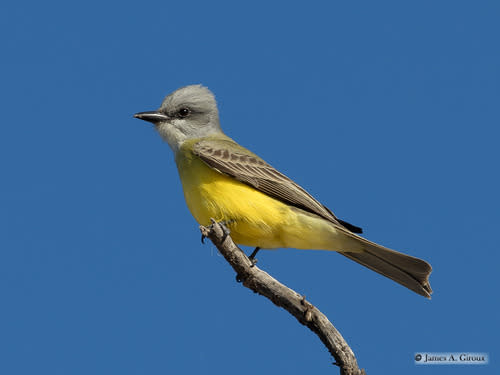
COURTESY: James Giroux
It’s not unusual to find Western Kingbirds nesting in trees in big box store parking lots. Look for them there, where they have bright spots of color that stand out in the usual grackle/rock pigeon crowd. They can be found all over town in large parks like Commons Ford and Roy Guerrero and smaller ones too, like Northwest Park. The small population of Couch’s seems to favor the Lady Bird Lake area.
Seeing Red The male Vermilion Flycatcher is an eye-dazzling flycatcher. Vermilions are sexually dimorphic, meaning the males and females look different. The bright red/orange male has a black mask and black wings, back and tail. The adult female is pale grayish brown with a white throat, streaking on her flanks and pinkish under her dark tail. A young female has more streaking and a yellowish wash under her dark tail. They like open habitat with a mix of trees, shrubs and brushy vegetation near water. There they perch on top of trees and shrubs, but they also will perch low in the lower branches of trees before sallying out to catch insects on the fly, and returning to the perch. This is similar to the Western Kingbird’s and Scissor-tail’s foraging strategy.
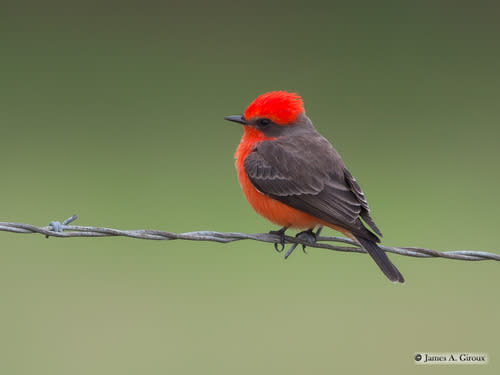
COURTESY: James Giroux
Unlike the Western Kingbird and Scissor-tailed Flycatcher the Vermilion is resident in most of its range in south and western Texas, and southern New Mexico, Arizona, and Nevada. It is also resident in Mexico.(Birds in Austin occasionally overwinter, while in other years they migrate further south. The Austin wintering population, which is small, did not fare well in the winter storm of February 2021, but appears to be recovering. It’s not a good strategy to be an insectivore in extended sub-freezing weather.) Vermilion Flycatchers are not as numerous as either the Western Kingbird or Scissor-tail. A few have recently been seen at Commons Ford Ranch, Bob Wentz Windy Point, and Mudd Cove at Pace Bend Park.
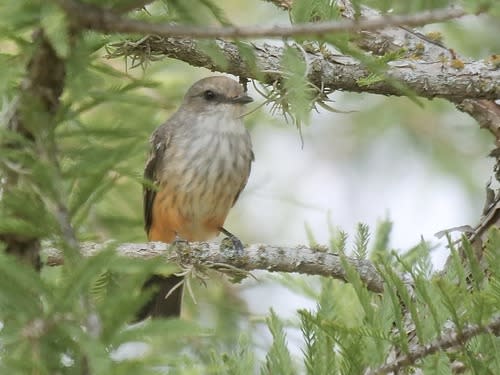
COURTESY: Jeff Osborne
The courting male has a distinctive twittering song that he sings as he flutters and glides as high as 60 to 100 feet above the surrounding trees. If the female is interested they will jointly look for nest sites. She incubates the eggs while he provides her food and they both feed the young.
Upcoming Travis Audubon Events – With all the colorful birds arriving, it’s time to plan an outdoor bird watching walk. Travis Audubon can help. Check the events calendar for upcoming events, field trips and classes. During April Travis Audubon hosts a Birdathon fundraiser, when many field trips both in and out of town, are offered for a fee. There are free offerings too. Most field trips require reservations.
Compiled by Jane Tillman, Travis Audubon Volunteer
References: All About Birds, Birds of the World and The Sibley Guide to Birds
For the latest news, weather, sports, and streaming video, head to KXAN Austin.
